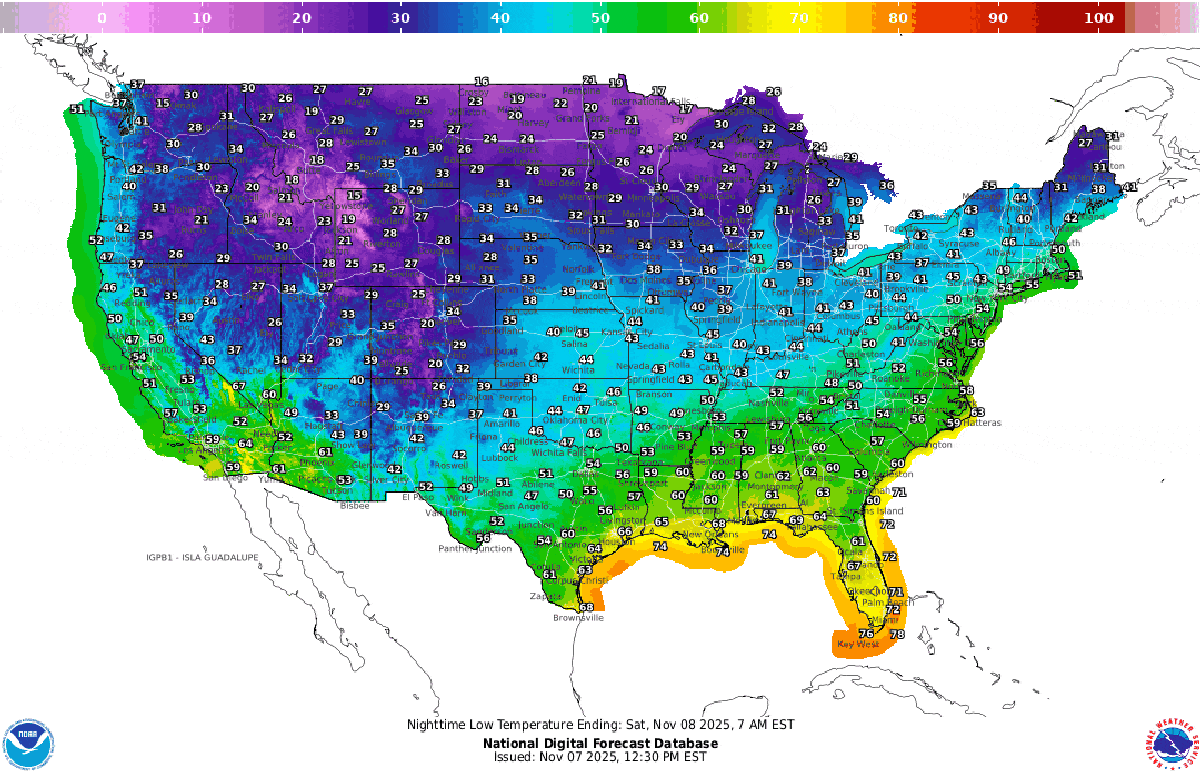Early Arctic Cold Blast Will Sweep Across the U.S., Potentially Breaking Records
An early cold snap will chill much of the U.S., potentially breaking records in the Southeast
Temperatures will drop across country as a cold snap moves first into the central U.S. and then eastward.
Join Our Community of Science Lovers!
A blast of frigid air will plunge into the central U.S. and move eastward over the next few days, potentially breaking records in a notably early cold snap. The most extreme cold will occur around November 10.
The event will be particularly notable in the southeastern U.S., where daytime and nighttime low temperatures may break records that have been held for decades, including some that have been in place for more than a century. All told, half the residents of the contiguous U.S. could experience temperatures below freezing, according to calculations by the New York Times.
The freezing temperatures may surprise many, given that swaths of the nation are currently relatively warm, with daily highs above average—parts of central Texas are even expected to crack 90 degrees Fahrenheit (32 degrees Celsius) on Friday, says Ashton Robinson Cook, a meteorologist at the National Weather Service’s Weather Prediction Center.
If you’re enjoying this article, consider supporting our award-winning journalism by subscribing. By purchasing a subscription you are helping to ensure the future of impactful stories about the discoveries and ideas shaping our world today.
But cold air is currently brewing over Canada. Simultaneously, a mass of low-pressure air is developing over the Great Lakes. Because air swirls counterclockwise around low-pressure systems, Cook says, the alignment will sweep frigid air deep into the central U.S. next Sunday and, from there, into the southeastern states next Monday and Tuesday.
Predominantly, the system will only affect temperatures, but parts of the Great Lakes region may see a few inches of snow. Cook notes that the precipitation forecast is still subject to change, however.
Because severe low temperatures will be concentrated in the Southeast, Floridians will need to beware of a notable regional hazard: cold-shocked iguanas that fall out of trees after losing blood flow, which can begin at temperatures as high as 50 degrees F (10 degrees C). Any such animals should be left alone, experts note, as they might not take kindly to rescue attempts once they warm up again.
Fortunately, the blast of frigid air will dissipate quickly, with temperatures rising throughout the southern and southeastern U.S. by next Wednesday. “The silver lining with this impending cold snap is that it should be relatively brief,” Cook says. “But it could be pretty intense.”
Meghan Bartels is a science journalist based in New York City. She joined Scientific American in 2023 and is now a senior reporter there. Previously, she spent more than four years as a writer and editor at Space.com, as well as nearly a year as a science reporter at Newsweek, where she focused on space and Earth science. Her writing has also appeared in Audubon, Nautilus, Astronomy and Smithsonian, among other publications. She attended Georgetown University and earned a master’s degree in journalism at New York University’s Science, Health and Environmental Reporting Program.
If you enjoyed this article, I’d like to ask for your support. Scientific American has served as an advocate for science and industry for 180 years, and right now may be the most critical moment in that two-century history.
I’ve been a Scientific American subscriber since I was 12 years old, and it helped shape the way I look at the world. SciAm always educates and delights me, and inspires a sense of awe for our vast, beautiful universe. I hope it does that for you, too.
If you , you help ensure that our coverage is centered on meaningful research and discovery; that we have the resources to report on the decisions that threaten labs across the U.S.; and that we support both budding and working scientists at a time when the value of science itself too often goes unrecognized.
In return, you get essential news, captivating podcasts, brilliant infographics, , must-watch videos, challenging games, and the science world’s best writing and reporting. You can even gift someone a subscription.
There has never been a more important time for us to stand up and show why science matters. I hope you’ll support us in that mission.
Thank you,
David M. Ewalt, Editor in Chief, Scientific American
Source: www.scientificamerican.com
